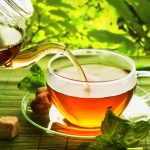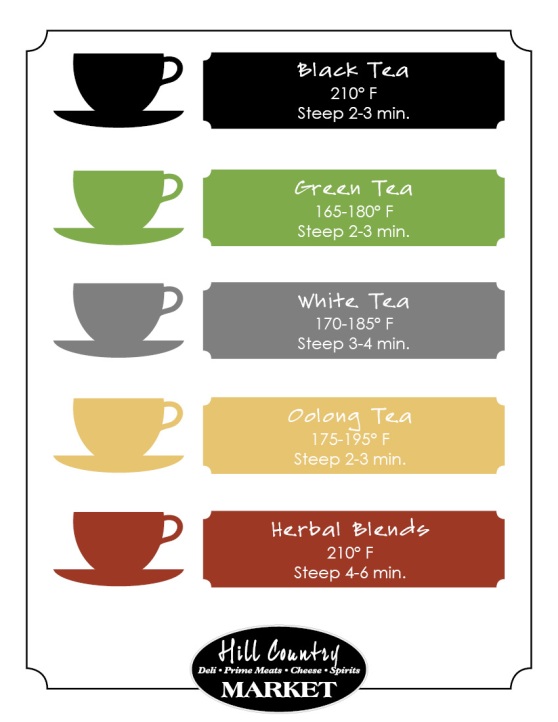 We’d like to take a moment to focus on tea, the benefits of tea, and how to prepare tea. While we more commonly focus on coffee here in the U.S., tea is the second most popular drink in the world, (second only to water), and has long been known as one of the healthiest beverage options.
We’d like to take a moment to focus on tea, the benefits of tea, and how to prepare tea. While we more commonly focus on coffee here in the U.S., tea is the second most popular drink in the world, (second only to water), and has long been known as one of the healthiest beverage options.
Preparing tea can be done in 3 simple steps:
1.Choose your tea
2. Heat Water
3. Steep your tea (using either bagged tea or a tea infuser)
While preparing tea is simple, there is also a wealth of fascinating information about tea and how to make a great cup of tea. Below, we’ve answered several common questions about tea:
“I’ve Tried Tea and it was Like Drinking Slightly Flavored Water.” Is this True of Tea? This statement is probably the most common we hear about tea by a non tea-drinker. But many who are not familiar with tea forget that there are thousands of varieties of tea, ranging from calm and mild tasting to bold and intense. Another factor for lack of flavor could be incorrect steeping time, or the use of a cheaper tea. Even replacing bagged tea with loose leaf tea can make all the difference. Of course, some people simply don’t enjoy tea just as some people don’t enjoy coffee.
What Tea Varieties are There? Tea originates from the plant Camella sinensis. From this single plant there are thousands of varieties of tea. The tea varies based on what region and soil it was grown in, the time of year it was picked, and how it was processed. The primary tea groupings include: green tea, white tea, oolong tea, black tea and herbal tea. Within each of these tea groupings are thousands of variations. Be aware that herbal teas, which include roobois teas, and mate teas are not made with the Camella sinensis plant. Herbal teas are blends of herbs, fruit, and flowers. Roobois teas are made from a South African red bush and mate teas are made from the twigs and leaves of the yerba mate plant.
I’ve Heated Up My Hot Water, Now How Do I Brew My Tea? After you’ve heated up your water, you can pour it into your cup or pot with your tea. If you’re using a bagged tea, simply add your tea bag to the cup of hot water. If you’re using loose leaf tea, spoon approximately 1 tablespoon, (per 8 oz. of water), of loose tea into your infuser and set your infuser into your cup of hot water. Keep in mind that with softer teas such as green or white you do not want to use too hot of water. With softer teas, too hot of water can often create a bitter taste to the tea. Once you’ve added your hot water, allow the tea to steep. The term ‘steep’ refers to allowing the tea to sit in the cup of hot water for the necessary amount of time. The amount of time for steeping tea commonly depends on the type of tea. Many tea brands will actually provide an estimated steeping time on the packaging or online for the tea. After trying the recommended time, you can also learn your preferred steeping time for different teas by experience. Allow your tea to steep a bit longer or shorter and see what you prefer. Keep in mind that with most teas, the longer you steep the tea the stronger and more bitter it can taste. Likewise, if you steep the tea for too short a time, you often get a weak taste. Commonly, loose leaf teas can steep a bit longer than a tea bag.
What is the Benefit of Loose Leaf Teas? Often, beginners in tea are uncertain of loose leaf teas as opposed to bagged teas. While bagged teas are quick and easy, the taste difference between the two is noticeable and the reason why so many choose loose leaf over bagged teas. The difference in taste comes from the amount and size of tea leaves used. When you purchase loose leaf tea, larger portions of tea leaves are used, providing a richer, fuller flavor. In tea bags, the tea leaf is often ground much smaller, which creates a less flavorful taste. Bagged teas can also increase the release of tannins, which gives the tea a harsher taste. An easy alternative to the tea bag is to purchase an infuser. To make loose leaf tea you will need either an infuser or tea bags that you can hand fill with your loose tea. Tea infusers come in many varieties with some for a single serving of tea and others for pots. With a tea infuser or two around the house, making loose leaf tea is just as efficient as using a bagged tea.
What are the Health Benefits to Drinking Tea? Tea has been known for its many health benefits for thousands of years and each tea can have different benefits. For example, most green teas are known for boosting your metabolism while black teas have been known to lower blood pressure. If you go even deeper into the tea variations, a green tea such as a peppermint green tea has been known to help calm stomach troubles.
Thankfully, the internet is also littered with helpful visuals on benefits of teas, steeping times and more. Here are a few we hunted down that we found to be beneficial.
The first image is a generalized chart about white tea, green, tea, etc. and their health benefits. The second chart focuses more on specific variations of tea.

(www.undergroundhealthreporter.com/drink-tea)
(totalbeauty.com)
This third chart we made as a great little companion for steeping tea:
We hope this tea 101 was helpful for those of you who already enjoy tea as well as those of you who are just becoming interested in the fascinating benefits of tea.
At Hill Country Market we offer a selection of high-quality tea provided by Wisconsin local, Rishi Tea. If you have more questions about tea and where to get started, stop in and visit us and our experienced staff can help answer your questions.
And for the coffee lovers out there, no worries, we will be discussing coffee soon as well.
Thanks for following!


